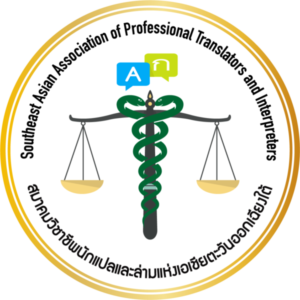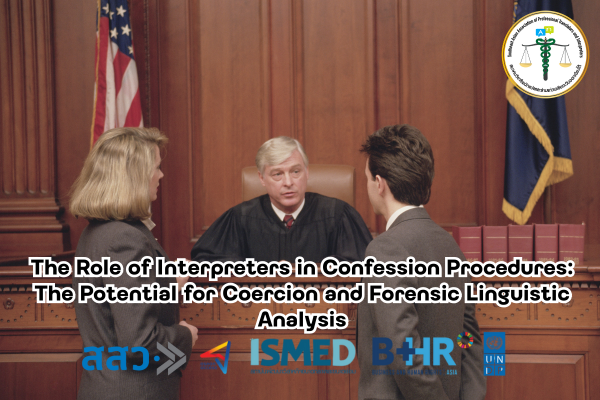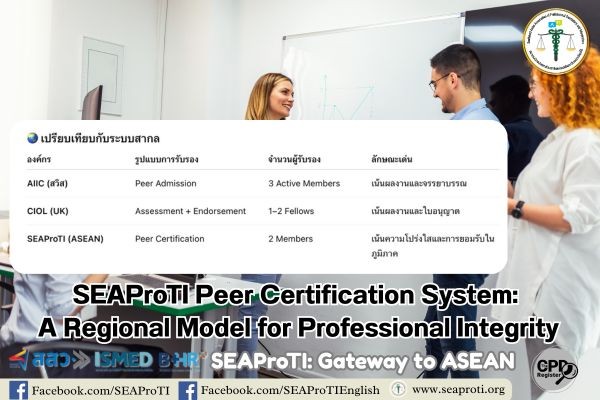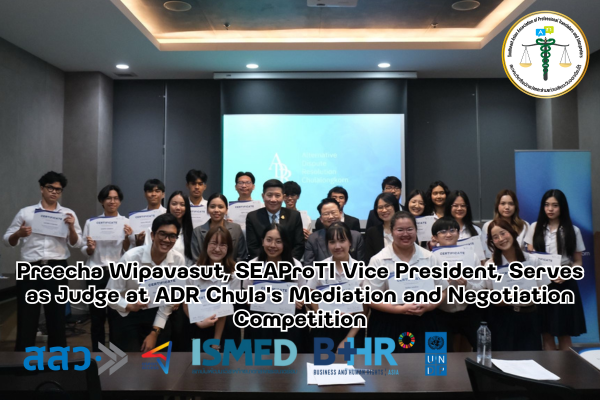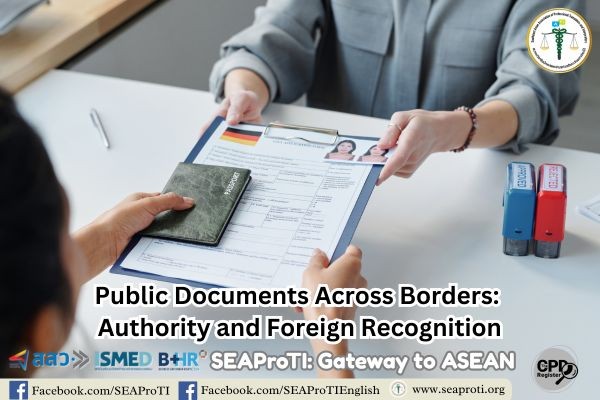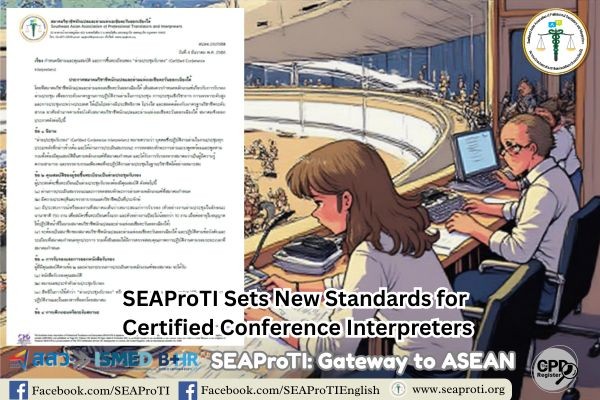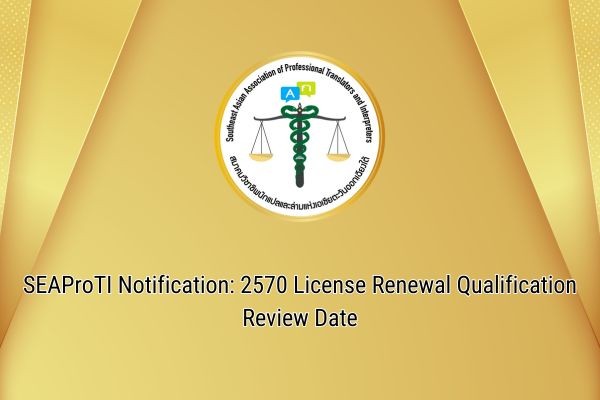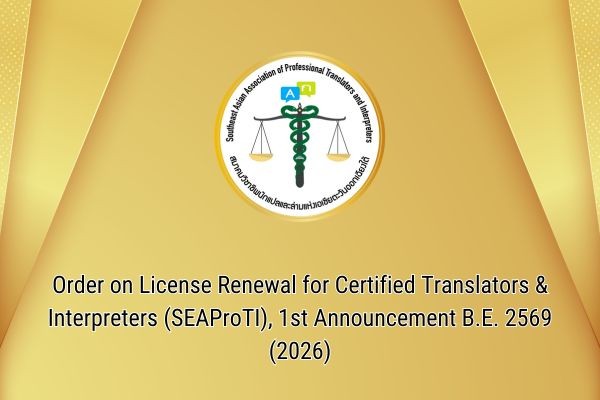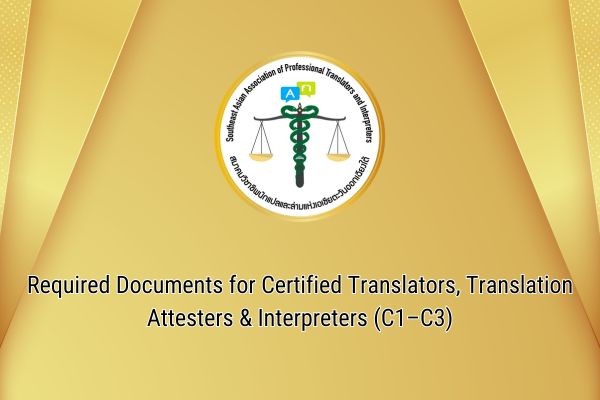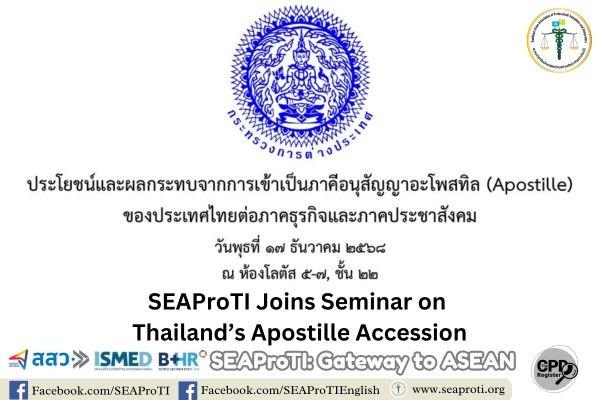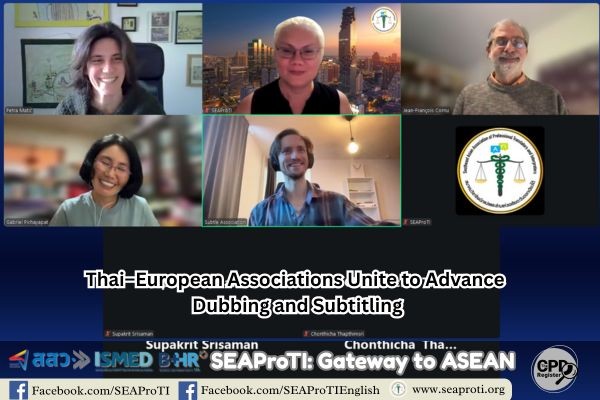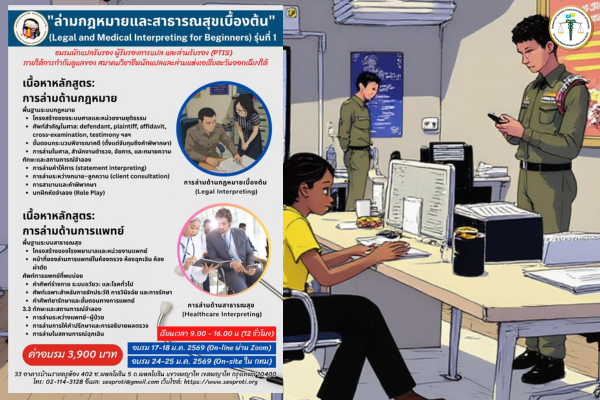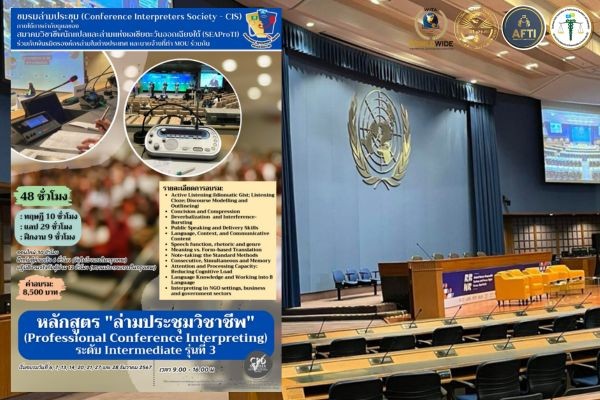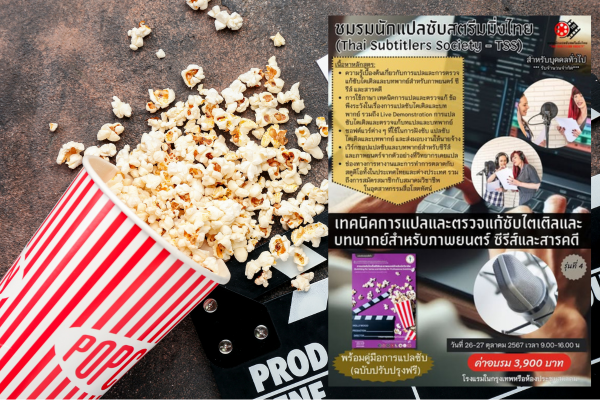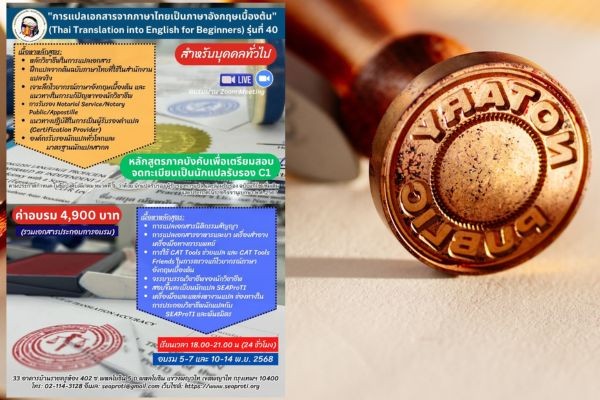The Role of Interpreters in Confession Procedures:
The Potential for Coercion and Forensic Linguistic Analysis
By Wanitcha Sumanat, President of the Southeast Asian Association of Professional Translators and Interpreters
1 May 2025, Bangkok – In criminal proceedings involving defendants who do not speak the language of the court, interpreters play a crucial role in safeguarding fundamental rights. However, confessions made through interpreters often occupy a grey area fraught with risks, particularly regarding the voluntariness of such confessions. The meaning conveyed by interpreters may not always be neutral; it may be influenced by linguistic structures, question framing, or even subtle pressure, either intentionally or unintentionally, on the part of the interpreter.
In numerous instances, the interpreter’s rendition may reflect language-based coercion or structural manipulation, potentially transforming a tentative or unclear statement into one of certainty. For example, an original statement such as “I don’t know if I did it” might be rendered by an interpreter as “He said he definitely did it.” This shift in meaning is not a minor error; it directly affects the legal weight of the confession and the accused’s legal standing.
Another common mechanism of distortion involves the use of leading questions such as “You stole it, didn’t you?” If the interpreter fails to preserve the coercive tone of the original question—or worse, translates it in a way that suggests a definitive answer—the resulting interpretation can no longer be considered neutral. In some cases, interpreters may even summarize or speak on behalf of the suspect, stating, for instance, that “He understands” when the individual is still visibly confused or hesitant. Such practices undermine the integrity of the confession process and raise serious concerns about the fairness of the investigation.
A landmark case that illustrates this issue is R v. Iqbal Begum (1985) in the United Kingdom. The defendant, a woman of Pakistani origin, had very limited English proficiency. The confession recorded by the police, with the aid of an interpreter, contained grammatically complex structures and legal vocabulary that the defendant was unlikely to have used on her own. The court expressed concern that the confession may have been linguistically manipulated, making it inadmissible as a voluntary statement.
A similar pattern has been documented in Australia in cases involving Aboriginal suspects. Dr. Diana Eades has shown that many suspects were questioned without interpreters who understood their regional dialects or cultural context. Even when interpreters were present, their translations were often marked by reduced nuance and excessive interpretation. Dr. Eades observed that authorities and interpreters frequently misinterpreted the word “Yes” to mean agreement or admission of guilt. In reality, in many Aboriginal cultures, “Yes” may simply mean “I hear you” or “I acknowledge your words,” without implying agreement or guilt.
From a forensic linguistic standpoint, Dr. Malcolm Coulthard of the UK highlights the phenomenon of voice appropriation—a process in which officials or interpreters project a voice or vocabulary onto the suspect that does not reflect the individual’s true linguistic register. The resulting confession is often written in formal, bureaucratic language rather than natural speech, especially when the suspect lacks fluency in the official language. This transformation strips the suspect of their voice and replaces it with that of the interpreter or the police.
Dr. Eades also emphasizes pragmatic failure—a breakdown in understanding the speaker’s intended meaning, particularly when the speaker’s cultural norms differ from those of the questioner. For example, suspects from certain cultural backgrounds may remain silent instead of expressing disagreement, which interpreters or officials may then wrongly interpret as an admission of guilt. These misunderstandings can have profound consequences in the justice process.
In conclusion, confessions mediated through interpreters must be scrutinized using forensic linguistic tools, as even slight alterations in meaning can significantly impact the outcome of a case. Interpreters must be trained not merely as language conveyors, but as neutral facilitators who are acutely aware of their responsibility to preserve the speaker’s intent, tone, and cultural nuance. Without this awareness, justice becomes vulnerable to distortion, and the rights of the accused may be compromised by the very mechanism designed to protect them.
References
Coulthard, M., & Johnson, A. (2007). An Introduction to Forensic Linguistics: Language in Evidence (2nd ed.). Routledge
https://doi.org/10.4324/9780203961333
Eades, D. (1995). Aboriginal English on trial: The case for recognition. In M. Walsh & C. Yallop (Eds.), Language and Culture in Aboriginal Australia (pp. 147–165). Aboriginal Studies Press
Eades, D. (2008). Courtroom Talk and Neocolonial Control. Mouton de Gruyter
https://doi.org/10.1515/9783110199003
Eades, D. (2010). Sociolinguistics and the Legal Process. Multilingual Matters
https://doi.org/10.21832/9781847692658
R v. Iqbal Begum, 82 Cr. App. R. 78 (1985). Court of Appeal (Criminal Division), United Kingdom
SEAProTI’s certified translators, translation certification providers, and certified interpreters:
The Southeast Asian Association of Professional Translators and Interpreters (SEAProTI) has officially announced the criteria and qualifications for individuals to register as “Certified Translators,” “Translation Certification Providers,” and “Certified Interpreters” under the association’s regulations. These guidelines are detailed in Sections 9 and 10 of the Royal Thai Government Gazette, issued by the Secretariat of the Cabinet under the Office of the Prime Minister of the Kingdom of Thailand, dated July 25, 2024, Volume 141, Part 66 Ng, Page 100.
To read the full publication, visit: the Royal Thai Government Gazette
บทบาทของล่ามในกระบวนการรับสารภาพ: ความเป็นไปได้ของการบีบบังคับและบทวิเคราะห์ทางนิติภาษาศาสตร์
โดย วณิชชา สุมานัส นายกสมาคมวิชาชีพนักแปลและล่ามแห่งเอเชียตะวันออกเฉียงใต้
1 พฤษภาคม 2568, กรุงเทพมหานคร – ในการพิจารณาคดีอาญาที่ผู้ต้องหามิใช่ผู้ใช้ภาษาหลักของกระบวนการยุติธรรม การใช้ล่ามถือเป็นกลไกสำคัญในการรับประกันสิทธิขั้นพื้นฐาน อย่างไรก็ตาม กรณีการรับสารภาพที่เกิดขึ้นผ่านล่ามยังคงเป็นพื้นที่สีเทาซึ่งเต็มไปด้วยความเสี่ยง โดยเฉพาะอย่างยิ่งในประเด็นเรื่องความสมัครใจของคำรับสารภาพ ซึ่งอาจถูกบิดเบือนไปจากต้นฉบับได้ หากถ้อยคำที่ล่ามแปลมิได้สะท้อนความหมายเดิมอย่างเป็นกลาง
ในหลายกรณี ถ้อยคำที่ถ่ายทอดโดยล่ามอาจสะท้อนถึงแรงกดดันเชิงโครงสร้างหรือเชิงภาษาโดยไม่ตั้งใจ หรือในบางกรณี ล่ามอาจใช้ภาษาที่มีนัยชี้นำจนทำให้คำรับสารภาพกลายเป็นผลผลิตของการแปลมากกว่าความตั้งใจของผู้ต้องหาเอง เช่น ถ้อยคำต้นฉบับที่แสดงความไม่มั่นใจ เช่น “I don’t know if I did it” อาจถูกแปลกลายเป็น “เขาบอกว่าเขาทำแน่นอน” (แปลผิด) ซึ่งเป็นการเปลี่ยนแปลงสาระสำคัญอย่างร้ายแรง อันนำไปสู่ข้อสงสัยเกี่ยวกับความถูกต้องของคำรับสารภาพนั้น
อีกหนึ่งกลไกที่พบบ่อยในการบิดเบือนความหมาย คือการใช้คำถามแบบปิดที่ชี้นำคำตอบ เช่น “คุณเป็นคนขโมยใช่ไหม” หากล่ามแปลโดยไม่รักษาน้ำเสียงของคำถาม หรือแม้กระทั่งเปลี่ยนเป็นคำถามเชิงยืนยัน ผลลัพธ์ที่ได้ย่อมไม่ใช่การแปลเชิงถ่ายทอดอย่างเป็นกลางแต่กลายเป็นการชักนำคำตอบอย่างแยบยล ล่ามบางรายอาจแปลหรือสรุปความแทนผู้ให้การ เช่น การบอกว่า “เขาเข้าใจแล้ว” โดยที่ผู้ให้การยังลังเลหรือไม่แสดงการยืนยันใด ๆ ซึ่งนอกจากจะบั่นทอนความแม่นยำแล้ว ยังเป็นการละเมิดสิทธิในการให้การโดยเสรีของผู้ต้องหา
กรณีศึกษาที่แสดงถึงความเสี่ยงนี้อย่างชัดเจน ได้แก่ คดี R v. Iqbal Begum (1985) ในสหราชอาณาจักร ซึ่งจำเลยเป็นหญิงชาวปากีสถานที่มีความสามารถทางภาษาอังกฤษจำกัดอย่างมาก ศาลพบว่า คำรับสารภาพที่ถูกรายงานไว้มีความซับซ้อนในเชิงไวยากรณ์และใช้คำศัพท์ที่เกินระดับภาษาที่จำเลยน่าจะใช้ได้ ศาลจึงตั้งข้อสังเกตว่าคำรับสารภาพดังกล่าวอาจมิได้เป็นคำพูดโดยสมัครใจ แต่เกิดจากการแทรกแซงทางภาษาโดยล่ามในระหว่างการสอบสวน
นอกจากนี้ ในกรณีของผู้ต้องหาชาวอะบอริจินในออสเตรเลียที่ได้รับการศึกษาจาก Dr. Diana Eades พบว่า การสอบสวนมักดำเนินไปโดยไม่มีล่ามที่เข้าใจภาษาถิ่นหรือความแตกต่างทางวัฒนธรรม แม้จะมีล่าม แต่การแปลกลับเต็มไปด้วยการลดทอนนัยของคำพูด และตีความเกินกว่าที่ผู้ถูกสอบสวนตั้งใจ เช่น คำตอบว่า “Yes” จากผู้ต้องหาชาวอะบอริจิน ซึ่งในบริบทวัฒนธรรมของเขาอาจหมายถึง “ฉันได้ยิน” หรือ “ฉันเข้าใจว่าคุณพูดอะไร” แต่กลับถูกตีความว่าเป็นการยอมรับผิด ซึ่งนำไปสู่ความผิดพลาดในกระบวนการยุติธรรมอย่างมีนัยสำคัญ
จากมุมมองทางนิติภาษาศาสตร์ ผู้เชี่ยวชาญอย่าง Dr. Malcolm Coulthard จากสหราชอาณาจักรได้อธิบายถึงปรากฏการณ์ที่เรียกว่า voice appropriation หรือ “การสวมเสียง” ซึ่งหมายถึงสถานการณ์ที่เจ้าหน้าที่หรือล่ามพูดแทนผู้ต้องหาโดยใช้ถ้อยคำที่เปลี่ยนระดับภาษา (register) และการเลือกคำ (lexical choices) จนไม่สามารถสะท้อนเสียงจริงของผู้ต้องหาได้ ถ้อยคำที่แปลในลักษณะนี้มักมีลักษณะคล้ายภาษาทางราชการที่ผ่านการเรียบเรียงมาแล้ว มากกว่าจะเป็นถ้อยคำธรรมชาติของผู้ถูกสอบสวน โดยเฉพาะเมื่อผู้ถูกสอบสวนเป็นบุคคลที่ไม่มีทักษะด้านภาษาอย่างเพียงพอในการต่อรองความหมาย
ในขณะเดียวกัน Dr. Diana Eades ยังชี้ให้เห็นถึง pragmatic failure หรือความล้มเหลวทางวัจนปฏิบัติ ซึ่งเกิดขึ้นเมื่อผู้ฟังตีความเจตนาผิดจากบริบททางวัฒนธรรมของผู้พูด ตัวอย่างที่พบบ่อย ได้แก่ การที่ผู้ต้องหาเลือกที่จะ “นิ่งเงียบ” แทนที่จะโต้แย้งเพื่อแสดงความไม่เห็นด้วย แต่ล่ามหรือเจ้าหน้าที่กลับตีความ “ความเงียบ” ดังกล่าวว่าเป็นการยอมรับผิด ซึ่งเป็นตัวอย่างชัดเจนของการแปลที่ไม่เพียงพอและก่อให้เกิดความเสียหายในทางกฎหมาย
โดยสรุปแล้ว การแปลคำรับสารภาพผ่านล่ามมิใช่เพียงการถ่ายทอดถ้อยคำแบบ “คำต่อคำ” หากแต่เป็นกระบวนการที่มีผลโดยตรงต่อความยุติธรรมในทางกฎหมาย ความผิดเพี้ยนของความหมายเพียงเล็กน้อยจากต้นฉบับอาจนำไปสู่ผลกระทบที่รุนแรงต่อชะตากรรมของผู้ต้องหา ด้วยเหตุนี้ คำรับสารภาพที่เกิดขึ้นผ่านล่ามจึงควรได้รับการวิเคราะห์ตรวจสอบด้วยเครื่องมือทางนิติภาษาศาสตร์ และล่ามควรได้รับการอบรมให้เข้าใจบทบาทของตนอย่างลึกซึ้งในฐานะ “ผู้ถ่ายทอดที่เป็นกลาง” มิใช่ “ผู้ตีความ” หรือ “ผู้ชี้นำ” ความหมาย มิฉะนั้นแล้ว ความยุติธรรมที่พึงมีในกระบวนการสอบสวนและดำเนินคดีอาจกลายเป็นเพียงภาพลวงตาในระบบที่ไม่ได้ยึดมั่นในหลักภาษาและวัฒนธรรมของผู้ให้การอย่างแท้จริง
เอกสารอ้างอิง
Coulthard, M., & Johnson, A. (2007). An Introduction to Forensic Linguistics: Language in Evidence (2nd ed.). Routledge.
https://doi.org/10.4324/9780203961333
คูลธาร์ด และ จอห์นสัน (2007). บทนำสู่นิติภาษาศาสตร์: ภาษาในฐานะพยานหลักฐาน (พิมพ์ครั้งที่ 2). สำนักพิมพ์รัทเลจ
Eades, D. (1995). Aboriginal English on trial: The case for recognition. In M. Walsh & C. Yallop (Eds.), Language and Culture in Aboriginal Australia (pp. 147–165). Aboriginal Studies Press
อีดส์, ไดอาน่า (1995). ภาษาอังกฤษแบบอะบอริจินในการพิจารณาคดี: ข้อเรียกร้องเพื่อการรับรอง. ใน วอลช์ และ ยัลล็อป (บ.ก.), ภาษาและวัฒนธรรมในออสเตรเลียของชาวอะบอริจิน (หน้า 147–165). สำนักพิมพ์ Aboriginal Studies Press
Eades, D. (2008). Courtroom Talk and Neocolonial Control. Mouton de Gruyter
https://doi.org/10.1515/9783110199003
อีดส์, ไดอาน่า (2008). วาทกรรมในห้องพิจารณาและการควบคุมแบบอาณานิคมยุคใหม่. สำนักพิมพ์ Mouton de Gruyter
Eades, D. (2010). Sociolinguistics and the Legal Process. Multilingual Matters
https://doi.org/10.21832/9781847692658
อีดส์, ไดอาน่า (2010). ภาษาสังคมวิทยากับกระบวนการยุติธรรม. สำนักพิมพ์ Multilingual Matters
R v. Iqbal Begum, 82 Cr. App. R. 78 (1985). Court of Appeal (Criminal Division), United Kingdom
คดี R v. Iqbal Begum, 82 Cr. App. R. 78 (1985). ศาลอุทธรณ์ฝ่ายอาญา สหราชอาณาจักร
เกี่ยวกับนักแปลรับรอง ผู้รับรองการแปล และล่ามรับรองของสมาคมวิชาชีพนักแปลและล่ามแห่งเอเชียตะวันออกเฉียงใต้
สมาคมวิชาชีพนักแปลและล่ามแห่งเอเชียตะวันออกเฉียงใต้ (SEAProTI) ได้ประกาศหลักเกณฑ์และคุณสมบัติผู้ที่ขึ้นทะเบียนเป็น “นักแปลรับรอง (Certified Translators) และผู้รับรองการแปล (Translation Certification Providers) และล่ามรับรอง (Certified Interpreters)” ของสมาคม หมวดที่ 9 และหมวดที่ 10 ในราชกิจจานุเบกษา ของสำนักเลขาธิการคณะรัฐมนตรี ในสำนักนายกรัฐมนตรี แห่งราชอาณาจักรไทย ลงวันที่ 25 ก.ค. 2567 เล่มที่ 141 ตอนที่ 66 ง หน้า 100 อ่านฉบับเต็มได้ที่: นักแปลรับรอง ผู้รับรองการแปล และล่ามรับรอง

